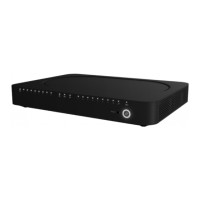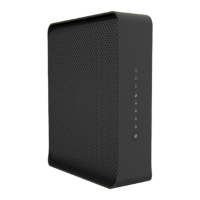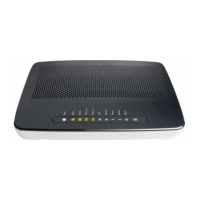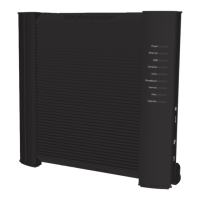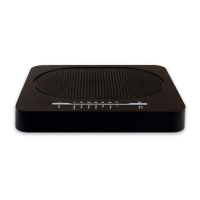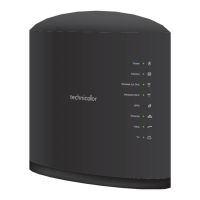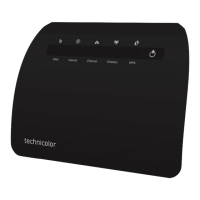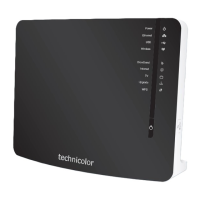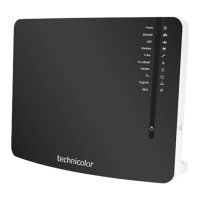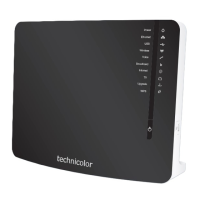Do you have a question about the Technicolor CGM4231 and is the answer not in the manual?
Visual overview of the gateway's front and top panels, including LED indicators.
Details about Tel ports, Ethernet switch, and other back panel ports.
Steps to access the web-based user interface for configuration.
High-level view of gateway connections and detailed gateway information.
Information on DOCSIS connectivity, signal parameters, and logs.
Details on DOCSIS state, system software, and hardware configuration.
Managing connected devices and configuring LAN settings.
Configuring WAN working mode, connection type, and IP settings.
Enabling IGMP proxy and configuring Routing Information Protocol (RIP).
Configuring MoCA interface and viewing modem parameters.
Configuring basic wireless parameters like SSID, mode, security, and encryption.
Advanced settings, guest Wi-Fi, and MAC address filtering.
Configuring Wi-Fi Protected Setup and Quality of Service.
Configuring firewall rules, IP filtering, and website blocking.
Blocking devices, filtering services, and setting up VPN tunnels.
Configuring email notifications and viewing security reports.
Configuring port forwarding, dynamic DNS, and DMZ host.
Enabling UPnP, IP passthrough, and media sharing features.
Managing user accounts and WiFi radio power.
Configuring remote access and backing up/restoring settings.
Rebooting, resetting, troubleshooting, and configuring remote logs.
Checking system, interface, and network status and configurations.
Diagnosing wireless, client, internet connectivity, and running self-tests.
Configuring traffic isolation and remote CPE management via TR-069.
Appendix on Web UI control and sample configuration file.
Glossary of terms and acronyms used in the guide.
Visual overview of the gateway's front and top panels, including LED indicators.
Details about Tel ports, Ethernet switch, and other back panel ports.
Steps to access the web-based user interface for configuration.
High-level view of gateway connections and detailed gateway information.
Information on DOCSIS connectivity, signal parameters, and logs.
Details on DOCSIS state, system software, and hardware configuration.
Managing connected devices and configuring LAN settings.
Configuring WAN working mode, connection type, and IP settings.
Enabling IGMP proxy and configuring Routing Information Protocol (RIP).
Configuring MoCA interface and viewing modem parameters.
Configuring basic wireless parameters like SSID, mode, security, and encryption.
Advanced settings, guest Wi-Fi, and MAC address filtering.
Configuring Wi-Fi Protected Setup and Quality of Service.
Configuring firewall rules, IP filtering, and website blocking.
Blocking devices, filtering services, and setting up VPN tunnels.
Configuring email notifications and viewing security reports.
Configuring port forwarding, dynamic DNS, and DMZ host.
Enabling UPnP, IP passthrough, and media sharing features.
Managing user accounts and WiFi radio power.
Configuring remote access and backing up/restoring settings.
Rebooting, resetting, troubleshooting, and configuring remote logs.
Checking system, interface, and network status and configurations.
Diagnosing wireless, client, internet connectivity, and running self-tests.
Configuring traffic isolation and remote CPE management via TR-069.
Appendix on Web UI control and sample configuration file.
Glossary of terms and acronyms used in the guide.
| Device Type | Gateway |
|---|---|
| DOCSIS Version | 3.1 |
| Wi-Fi Bands | Dual-band |
| Ethernet Ports | 4 |
| Telephony Ports | 2 |
| USB Ports | 1 |
| USB Version | 3.0 |
| Maximum Upload Speed | 1 Gbps |
| MoCA | No |
| Weight | 1.5 lbs |
| Wi-Fi Standard | 802.11ax |


